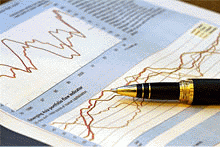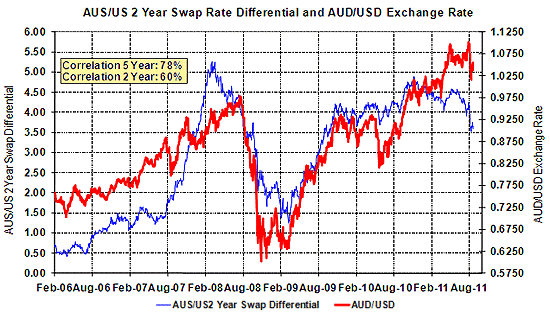
 By Roger J Kerr
By Roger J Kerr
Nearly all the forwards indicator drivers of the NZD/USD exchange rate value currently point to the Kiwi being nearer to 0.7000 than the current 0.8180 exchange rate value.
An observation of historical correlations and linkages of the NZ dollar rate to the EUR/USD rate, CRB Index, Wholemilk Powder prices, VIX sharemarket volatility Index, Dow Jones Index, the 2-year NZ:US interest rate swap differential, US ISM Index and Chinese PMI Index all suggest a much lower NZD/USD rate.
Three plausible and standout reasons why the NZ dollar has not depreciated to the low 0.7000’s, as these indicators suggest, are as follows:
1. Over and above all the aforementioned drivers, the dominating NZD/USD determinant is the AUD/USD exchange rate.
The very stable NZD/AUD cross-rate through all the wild currency market volatility of recent weeks just tells you how much the Kiwi is closely tracking AUD movements against the USD.
The AUD appreciation in 2010 and early 2011 on higher commodity prices and higher interest rates outweighed the other drivers.
2. Relatively speaking, on one particular economic fundamental ratio of Government debt to GDP, New Zealand looks very good against most other countries that are plainly awful at this time.
However, international fund managers and their economists rating NZ up there on this metric seem to be foolishly ignoring our very high household debt ratio to GDP.
3. The global funds parked temporarily in New Zealand dollars ahead of the US debt ceiling ultimatum date of 2 August may not have fully reversed out again.
The dramatic pull-back in the NZD from highs of 0.8840 to 0.8000 over recent weeks indicates that most of the money has flown back out, however perhaps not all.
Situation changed
The rise in the NZD/AUD cross rate from 0.7500 to above 0.8000 two months ago was based on the prospect of NZ interest rates increasing from September and the NZ/Australian interest rate differential closing up. The situation has now changed with the high NZD forcing the RBNZ to have a much more downbeat Monetary Policy Statement in September than the upbeat prognosis they delivered back in June.
New Zealand interest rates will be lower for longer and thus the NZD has already started to pull back below 0.8000 against the AUD.
However, the AUD/USD direction over coming months will remain as the dominant driver of the NZ dollar direction.
An analysis of current developments in Australia leads to a conclusion that the luck may have run out for the lucky country and its currency. Australia sailed through the GFC without a domestic economic recession, without a property market downturn and the mining resources sector boomed away on strong Chinese demand. Australia therefore never made any business and economic adjustment to the new world order, which may be catching up with them now.
Recent Australian domestic economic data has all been very weak in the retail, manufacturing, housing and employment areas. Non-resource sector exporters have been pounded by the high Australian dollar. Retailers cannot compete against cheaper prices for stuff purchased in USD online. Local manufacturers are losing money and market share to cheaper imports. The high Aussie dollar and their higher mortgage interest rates over the past 12 months has created the two-speed economy with NSW and Victoria states hit hard compared to the mining states of WA and Queensland.
BlueScope Steel is downsizing its Port Kembla steel mill with a thousand jobs lost as they cannot operate profitably with the high AUD and high coking coal input prices. OneSteel axed 400 steelmaking jobs last week in Australia. Another iconic Australian company, Qantas appears to be in disarray as they battle with union-controlled, over-priced pilots and staff in Australia.
All is not well across the ditch.
Lower global GDP growth forecasts over recent weeks have forced hard commodity prices downwards, potentially threatening the one area of positive economic activity that has been holding the Australian economy together.
As a result of these economic shifts, Australian interest rate markets have completed an incredible U-turn since May.
They are now pricing-in 1.00% reductions in official interest rates over the next 12 months, a sharp reversal from the forward pricing that had increases built in only three months ago.
The sudden decreases in Australian swap interest rates have removed one of the positive supports for the AUD, as the chart below of US/Australian 2-year swap rate differential depicts. The interest rate gap points to the AUD/USD exchange rate falling away from its current $1.040 level to well below $1.0000 over coming weeks/months.
Where the Aussie dollar goes, we follow.
An RBA testimony speech by Governor Glenn Stevens this Friday, coupled with preliminary Chinese PMI data this week may be catalysts for the AUD currency market to turn much more bearish in the same way their interest rate markets have turned in recent weeks.

No chart with that title exists.
--------------------
* Roger J Kerr runs Asia Pacific Risk Management. He specialises in fixed interest securities and is a commentator on economics and markets. More commentary and useful information on fixed interest investing can be found at rogeradvice.com

We welcome your comments below. If you are not already registered, please register to comment
Remember we welcome robust, respectful and insightful debate. We don't welcome abusive or defamatory comments and will de-register those repeatedly making such comments. Our current comment policy is here.